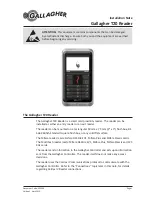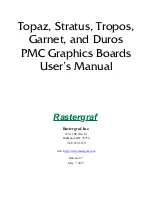
XRT86VL38
PRELIMINARY
xr
OCTAL T1/E1/J1 FRAMER/LIU COMBO
REV. P1.0.6
325
Where D5 is the MSB and D0 is the LSB. The rightmost "1" is transmitted first. BOS is classified into the
following two groups.
•
Priority Codeword Message
•
Command and Response Information
5.7.2
Priority Codeword Message
A Priority Codeword Message is preemptive and has the highest priority among all data link information. A
Priority Codeword indicates a condition that is affecting the quality of service and thus shall be transmitted until
the condition no longer exists. The duration of transmission should not be less than one second. A priority
codeword may be interrupted by software for 100 milliseconds to send maintenance commands with a
minimum interval of one second between interruptions. Yellow alarm (00000000 11111111) is the only priority
message defined in industry standards.
5.7.3
Command and Response Information
Command and Response Information is transmitted to perform various functions. The BOS Processor can
send a command and response by transmitting a minimum of 10 repetitions of the appropriate codeword
pattern. A Command and response data transmission initiates action at the remote end, while the remote end
will respond by sending Bit-Oriented response message to acknowledge the received commands. The
activation and deactivation of line remote loop-back and local payload loop-back functions are of this type.
5.8
Transmit MOS (Message Oriented Signaling) Processor
The Transmit LAPD controller implements the Message-Oriented protocol based on ITU Recommendation
Q.921 Link Access Procedures on the D-channel. It provides the following functions.
•
Zero stuffing
•
T1/E1 transmitter interface
•
Transmit message buffer access
•
Frame check sequence generation
•
IDLE flag insertion
•
ABORT sequence generation
Two 96-byte buffers in shared memory are allocated for each LAPD to reduce the frequency of microprocessor
interrupts and alleviate the response time requirement for a microprocessor to handle each interrupt. There
are no restrictions on the length of the message. However the 96-byte buffer is deep enough to hold one entire
LAPD path or test signal identification message.
5.8.1
Discussion of MOS
Message-Oriented signals sent by the transmit LAPD Controller are messages conforming to ITU
Recommendation Q.921 LAPD protocol. There are two types of Message-Oriented signals. One is a periodic
performance report generated by the source or sink T1/E1 terminals as defined by ANSI T1.403. The other is
a path or test signal identification message that may be optionally generated by a terminal or intermediate
equipment on a T1/E1 circuit. The message structures of the performance report and path or test signal
identification message are shown in Figure 39 for format A and format B respectively.
















































